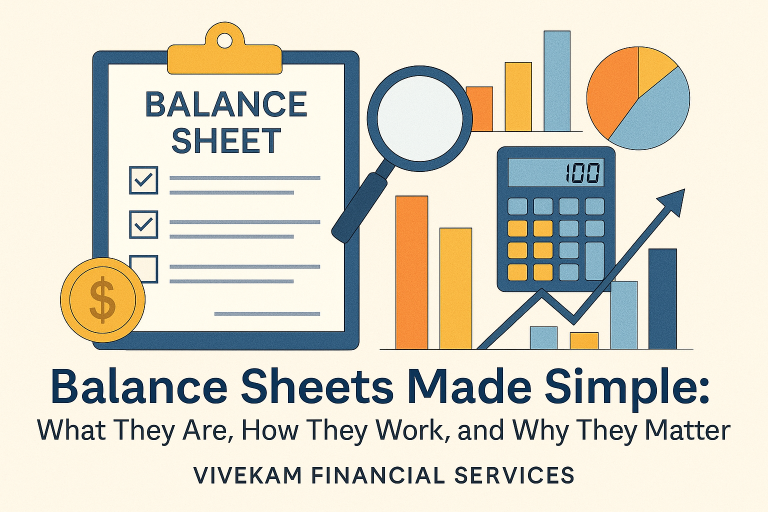Balance Sheets Made Simple: What They Are, How They Work, and Why They Matter

The Balance Sheet
A balance sheet is basically a snapshot of your business’s financial health.
It shows what you own, what you owe, and what’s left over — that last part being your equity.
If you think of your business like a car, the balance sheet shows:
- The car’s value (assets)
- The loan you owe (liabilities)
- And what’s truly yours after paying off debt (equity)
It’s one of the three key financial statements every business needs, alongside the income statement and cash flow statement.
Why Every Business Needs a Balance Sheet
A balance sheet isn’t just an accounting requirement — it’s your financial compass.
It tells you if you’re growing sustainably or living on borrowed time.
You can use it to:
- Track debt vs equity over time.
- Spot cash flow problems before they get serious.
- Help investors and banks assess your creditworthiness.
Breaking Down the Core Elements
Let’s make the balance sheet formula make sense:
Assets = Liabilities + Equity
Here’s what that actually means:
- Assets are what you own — cash, property, inventory, investments.
- Liabilities are what you owe — loans, bills, payroll obligations.
- Equity is the part that belongs to you or your shareholders once the debts are paid.
This equation always balances because every financial action affects both sides equally.
How It All Fits Together
Think of assets as your engine, liabilities as your fuel costs, and equity as your ownership stake in the ride.
If assets go up (say, you buy new equipment), either liabilities (loan) or equity (owner’s money) must also go up. That’s how a balance sheet stays balanced.
What a Good Balance Sheet Looks Like
A strong balance sheet is clear, consistent, and credible.
It should show:
- Assets correctly valued
- Liabilities realistically recorded
- Equity that adds up cleanly
Good accounting software like QuickBooks, Zoho Books, or Xero helps keep everything aligned.
Preparing a Balance Sheet (Step-by-Step)
- List all assets. Start with what’s most liquid (cash, receivables).
- List all liabilities. Separate current (due within a year) and long-term.
- Calculate equity. Include owner’s capital, retained earnings, and any share issues.
- Check that formula: Assets = Liabilities + Equity.
If it doesn’t balance, something’s off — usually a missed adjustment or wrong entry.
Balance Sheet Formats (and Which One You Should Use)
You’ll usually see two styles:
- Vertical format: Items listed top-down. Most modern reports use this.
- T-format: Old-school “Assets on left, Liabilities + Equity on right.”
The vertical format is easier for digital use and quick reading.
Different Types of Balance Sheets
Depending on the context, you might work with:
- Classified: Organized into current/non-current categories.
- Comparative: Shows changes over multiple periods.
- Common-size: Expresses every line as a % of total assets — great for benchmarking.
Balance Sheet vs Income Statement
|
Focus Area |
Balance Sheet |
Income Statement |
|
Purpose |
Shows financial position |
Shows performance over time |
|
Time Frame |
Single date |
Covers a period |
|
Key Items |
Assets, liabilities, equity |
Revenue, expenses, profit |
|
Main Question |
“What do we have?” |
“How did we perform?” |
They work hand in hand — profits from the income statement increase equity on the balance sheet.
Seeing It in Action (Simple Example)
|
Particulars |
Amount (₹) |
|
Cash |
15,000 |
|
Inventory |
5,000 |
|
Equipment |
10,000 |
|
Total Assets |
30,000 |
|
Accounts Payable |
8,000 |
|
Long-Term Loan |
7,000 |
|
Total Liabilities |
15,000 |
|
Owner’s Equity |
15,000 |

Avoid These Balance Sheet Blunders
- Forgetting depreciation or accrued expenses.
- Mixing short- and long-term liabilities.
- Not matching period-end data with other statements.

FAQs
Q1: What’s the easiest way to explain a balance sheet?
A: It’s a snapshot of what your business owns, owes, and is worth at a specific moment.
Q2: What’s the balance sheet formula?
A: Assets = Liabilities + Equity.
Q3: How is it different from an income statement?
A: The balance sheet shows position; the income statement shows performance.
Q4: Why must a balance sheet balance?
A: Because every financial event affects both sides equally — it’s the core of double-entry accounting.
Q5: Can individuals have a balance sheet?
A: Absolutely. Personal balance sheets show your net worth — assets minus liabilities.
Final Thoughts
Understanding balance sheets isn’t just for accountants — it’s for anyone who wants to see the real story behind their finances.
Once you grasp the format, formula, and flow, you’ll read one like a pro — and make better decisions in business or investing.







